Respected reader,
Good, crisp, professional communication is often at the heart of every successful business project. It’s an art that every professional must master. If you are new to the business world or want to improve your communication standards, you have come to the right article.
A major part of professional communication occurs via business letters. They are used in every context and set the tone for all business transactions between two parties. Business letters also serve as records for a company to train its employees and refer to older transactions.
You can learn how to write a business letter for every occasion by understanding the structure and formats you can leverage. Let’s dive right into it.
Table of contents
What is a business letter?
A business letter is an official communication between organizations or individuals regarding official matters. It’s important to follow the right format, use the right tone, and be straight to the point for clear communication. The language used in business letters must closely reflect your business’ brand identity
Business letters often form a big part of the first impression your organization wants to make on the other, so it’s important to get it right.
When to use a business letter?
Ricks and Gow, authors of Business communication: Systems and Applications, say that, “The primary purposes of business letters are to inform, instruct, request, inquire, remit, order, advise, correct and to question.”
This statement explains that business letter-writing knowledge can come in handy on many occasions. Studies show that effective communication contributes significantly to project success.
Some use-cases for business letters include making a sales pitch, placing orders, making complaints, acknowledging receipt of payments, and submitting business proposals, etc.
Types of business letters
Business letters are classified into different types based on their purpose. Each has a unique structure and tone tailored to its specific purpose. Understanding the different types, specific purposes, and proper ways to address a business letter can help individuals and organizations surpass communication barriers and achieve their objectives.
Cover letters
A cover letter accompanies a package, report, or official document. It explains the contents and gives instructions to the recipient on how to handle it.
Proposal letters
Businesses leverage proposal letters to their partners, peers, and prospective clients to propose a business idea, project, or partnership. These letters aim to convince the recipient to act upon or endorse the business proposal.
Thank you letters
To express gratitude and appreciation to a person or organization for their assistance, support, or services provided, you can write a thank you letter. The tone here is usually courteous and grateful.
Complaint letters
Businesses often use complaint letters to convey their dissatisfaction effectively. In such instances, it’s essential to balance expressing your displeasure and avoiding excessive anger to maintain an air of professionalism. You can also offer suggestions to the recipient on rectifying the situation.
Memos
A memo is an internal document/business letter used to communicate essential and sensitive information, announcements, or instructions to employees within an organization. It is an important asset in workplace communication as it directly impacts productivity and morale.
Acknowledgment letters
Acknowledgment letters help confirm the receipt of an item or to acknowledge a fact or error highlighted by someone. These letters should include the date of receiving the package or information and express gratitude towards the sender for their contribution.
Response letters
Response letters address a previous letter or inquiry, provide information, or confirm the necessary actions.
Letters of request
You can use these to secure additional information on a matter, request for additional resources to your superior in the organization, or secure a professional favor from someone outside the organization. When writing such letters, seeking assistance without appearing excessively emotional or desperate is important. Therefore, it’s important to consider the adjectives used in the letter carefully.
Congratulatory letters
Such letters aim to congratulate someone on their achievements, promotions, or other accomplishments. The letter should outline the reason for offering congratulations and highlight any positive feedback.
Parts of a business letter
Let’s begin by getting familiar with the different parts of a business letter. These parts bring the letter together and help convey a sense of professionalism. Knowing them and using them right makes the business letter much more impactful.
If you're just starting your business, having a solid grasp of business letter writing is crucial. Below we've provided a handy checklist of key components to get you started.
Heading or letterhead
Essential information about an organization, such as its name, address, contact details, branding, and registration number, is usually found at the top center or right side of a letterhead.
Date
This reflects the date of writing the letter. However, if you happen to send it out later, you may want change it to the date you send the letter. It’s an important part as the date of the letter often forms the basis for filing and organization within a business.
Inside address
The inside address or the recipient’s address includes the name, address, postal code, and job title of the person, organization name, and which the sender is writing to. It’s generally written on the left-hand side of the sheet, with one piece of information on each line.
Subject
The subject is a brief statement that mentions the sender’s reason for writing the letter. You can write it separately after the recipient’s address or incorporate it in the first line of the opening paragraph. It helps to clarify the document’s purpose in the subject because it ensures the reader is prepared for what is coming within the body.
Greeting
The greeting is the word used to greet the recipient. It’s also known as the salutation. The type of salutation will depend on the sender’s relationship with the receiver. A formal business letter generally uses salutation words like “Respected,” or “Sir/Madam.” A comma (,) usually follows the salutation. It can be appropriate to use the recipients name, but if none of the previous examples make sense, you can address a department or group within the recipient business instead.
Body of the letter
This is the main part of the letter, containing the actual message from the sender. You can divide the body of the letter into three main categories:
Opening
The first paragraph of the letter introduces the writer and may reference any previous correspondence. It further establishes the writer’s purpose of writing the letter.
Main section
This can be written in one or two paragraphs. It states the main idea or reason for writing and should be clear, concise, complete, and to the point. Consider using short lists here to keep attention and break up the visual flow of the letter.
Conclusion
The letter’s conclusion reiterates the suggestions or need for action, and the letter’s closing reflects the sender’s expectations from the recipient. It’s best to end your letter with courteous words, like “Thank you,” “Warm regards,” or “I look forward to hearing from you.”
Complimentary close
The complimentary close is a humble way of ending the letter and is written in accordance with the salutation. Commonly used complimentary closes are “All the best”, “Sincerely,” “Yours faithfully,” “Yours sincerely,” and “Thanks & Regards.”
Signature and writer’s identification
This section includes the signature, name, and designation of the sender, as well as other details such as contact numbers and addresses. The signature is handwritten just above the name of the sender. This detail adds credibility and can be important when the letter contains a potentially legally binding contract.
Optional components of a business letter
- Reference number: An essential element of correspondence is the reference number – an identifying figure printed either below or beside the date. Primarily, this allows for replies to be linked with initial messages to form a thread and facilitate timely communication between the parties.
- Enclosures: Enclosures refer to the documents attached to the letter, such as cheques, drafts, bills, receipts, or invoices.
- Copy circulation: Copy circulation or “C.C” comes in handy when the copies of the letter are sent to others besides the intended sender.
- PostScript: The postscript OR “P.S” is useful for the sender when they want to add something other than the message in the body of the letter.
Mastering the different parts of a business letter is essential to crafting effective communication. Applying this knowledge to an appropriate format will help you create professional and polished correspondence. In the next section, we will explore common business letter formats, helping you choose the right one for your specific needs.
Common business letter formats and examples
When it comes to writing a business letter, the format you choose can have a significant impact on the effectiveness of the message. Depending on the letter’s purpose and your personal preference, you can choose from several formats such as block format, modified block format, and semi-block format.
Each format has its own unique features, which can help you achieve your desired tone and level of formality. In this section, we will guide you through the different professional letter formats and help you determine which one is the most suitable for your specific needs.
So, let’s dive in and explore the business letter formats you can leverage.
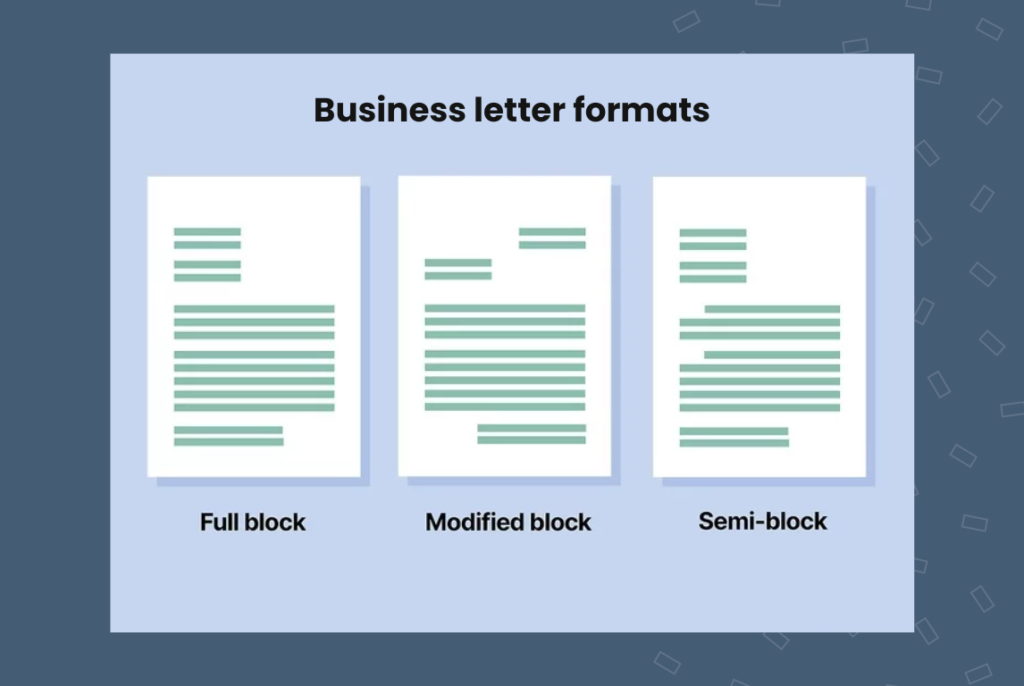
Block formatting
Block formatting is the most commonly used formal business letter format. In this format, the entire text is left-aligned with single-spaced paragraphs separated by double spaces between them. There is no indentation at the beginning of the letter or document. The paragraphs are written as blocks, as per the name of the format.
This style is designed to give the text a professional and clean appearance, making it easy to read and understand. This format is commonly used in law, finance, and similar industries prominently. Here are two such sample business letter format examples for easy reference and understanding:
Block formatting in business letter
Example 1: A thank you letter
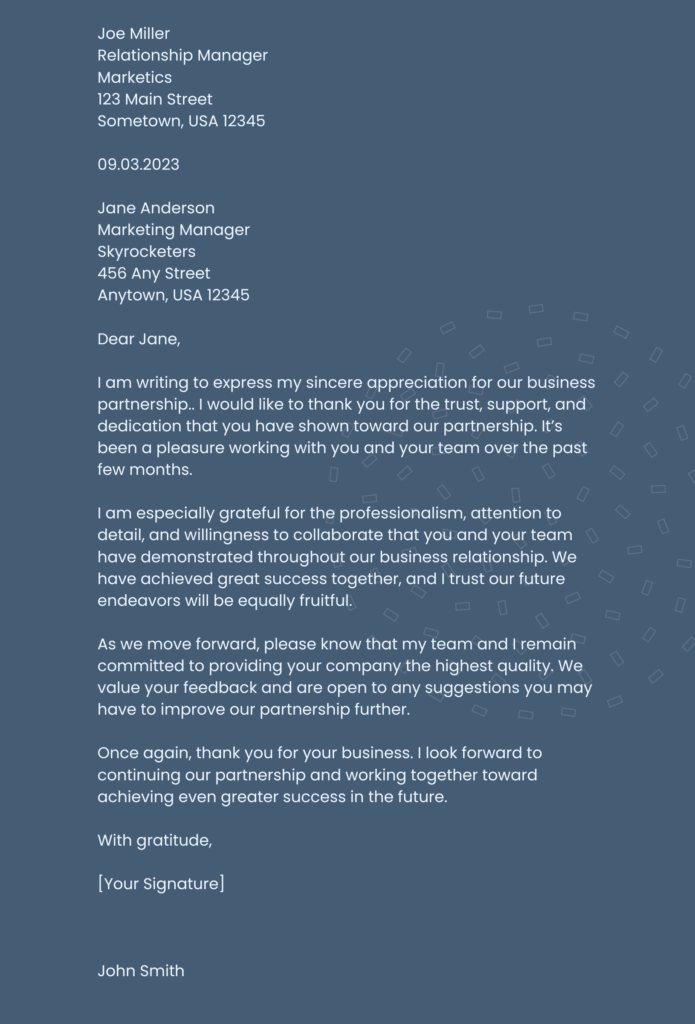
Example 2: A complaint letter
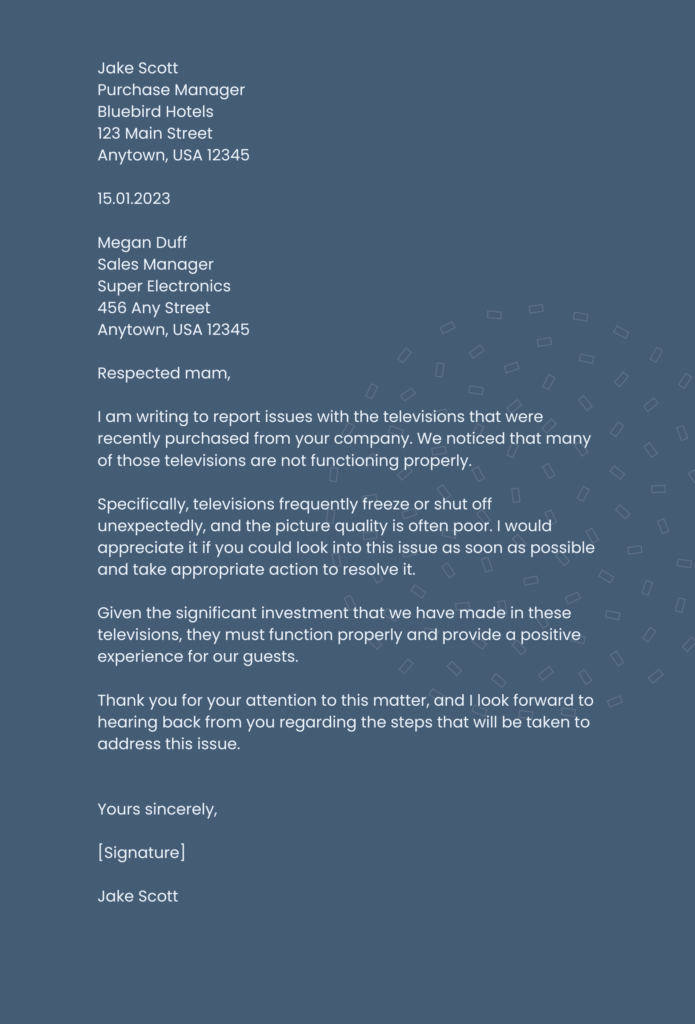
Modified block formatting
This business letter format is similar to block formatting, but the sender’s address, date, complimentary closing, and signature line are aligned to the right margin. Modified block format is ideal for business letters that are a little informal but also require a professional touch. A few examples include internal memos or letters to colleagues.
It provides a clean and modern appearance.
Here are two examples of business letter templates in this format:
Modified block formatting in business letter
Example 1: A business proposal letter
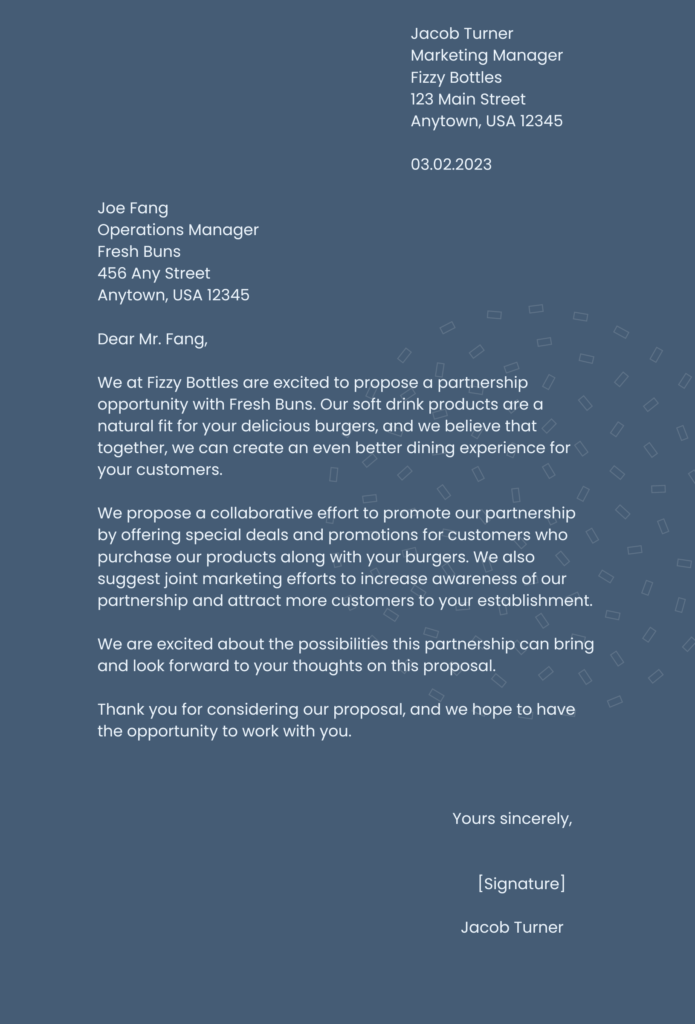
Example 2: A congratulatory letter
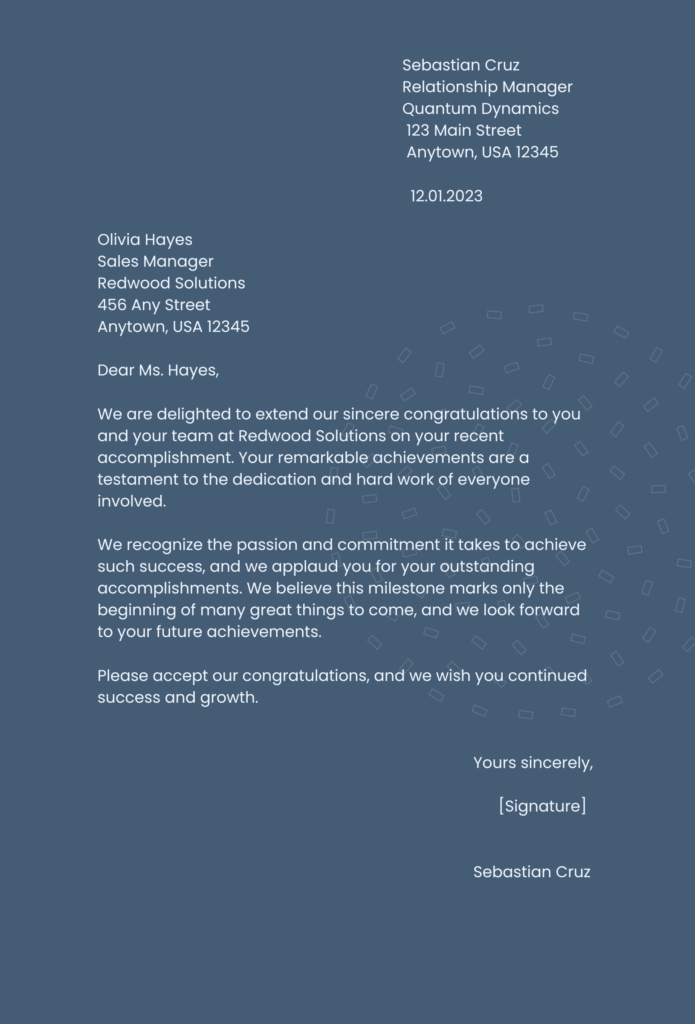
Semi-block formatting
The only difference between this business letter format and modified block formatting is that in semi-block formatting, the first line of each paragraph is indented. The semi-block format is used for less formal business letters, creating a casual tone in the relationship.
Overall, the semi-block format is ideal for personal business letters or letters of inquiry. Here are two business letter examples in this format for reference:
Semi-block formatting in business letters
Example 1: An acknowledgment letter
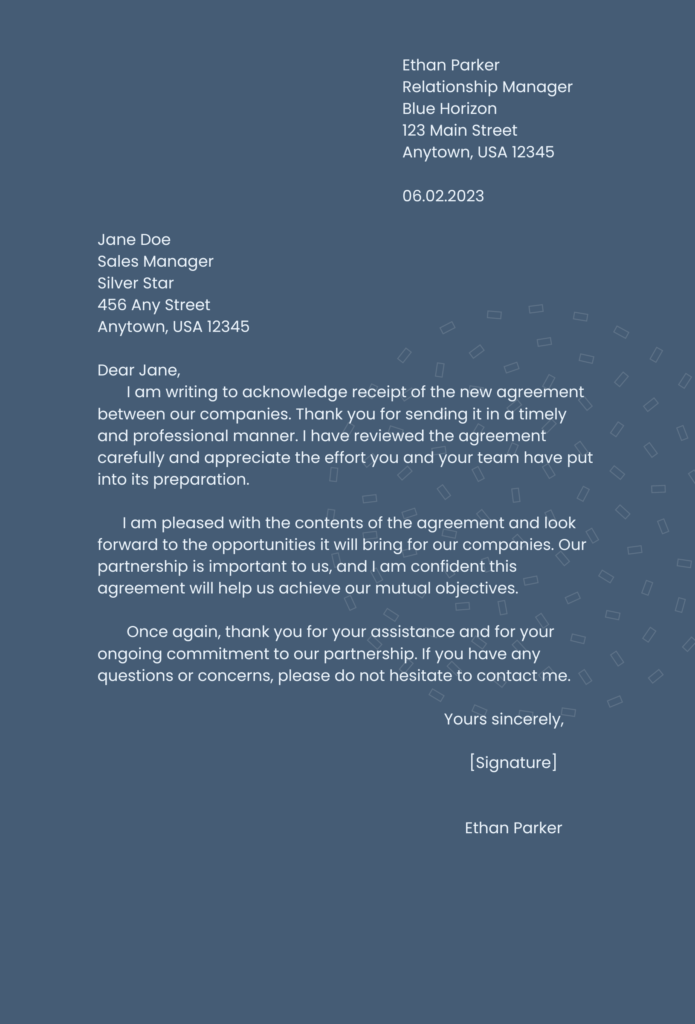
Example 2: A response letter
Knowing the different formats will help you make the right choice for your company’s needs. Before you write a business letter, understand the relationship between the sender and receiver, choose the tone you wish to set, and then proceed.
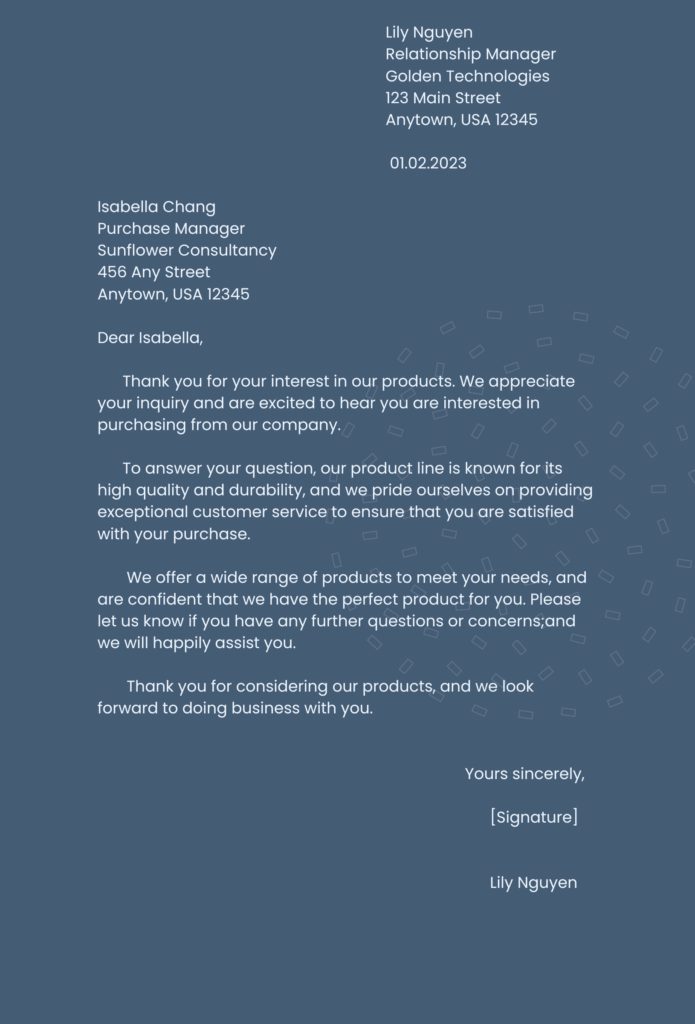
Knowing the different formats will help you make the right choice for your company’s needs. Before you write a business letter, understand the relationship between the sender and receiver, choose the tone you wish to set, and then proceed.
How to write a formal business letter
The overall goal of a business letter is to communicate a clear message in the most professional way possible. This requires attention to detail, proper formatting, correct grammar, and accurate spelling. A well-written business letter can build a positive image for your company and can make communication more effective.
1. Create margins.
The first step in writing a business letter is to create margins. The standard margins for a business letter are one inch on all sides.
2. Choose the right font.
Choosing the right font is essential to make the letter look professional. Some standard recommended fonts are Times New Roman, Arial, or Calibri. A size 12 font is standard for formal business letters as it’s easy to read and looks professional. Using a different size may affect the readability and make it look a bit unprofessional.
3. Pick a format.
Choose a format for your letter based on the purpose and recipient of the letter. Block format is suitable for formal business letters like cover letters, thank-you letters, and letters of recommendation. Modified block format works for less formal letters like internal memos or letters to colleagues. Semi-block format is good for personal business letters or letters of inquiry.
4. Single-space the text.
Single-space the text of your letter. Double spacing makes the letter appear longer than it needs to be.
5. Add addresses.
Include your address and the recipient’s address at the beginning of the letter.
6. Add the date.
The date is typically written below the heading.
7. Write the body of the letter.
The body of the letter should include a clear introduction, a well-structured main message, and a professional conclusion. Maintain a respectful and polite tone in your letter’s tone and organization since it determines how people receive your message.
It’s important to use formal language and avoid contractions or slang. Use punctuation correctly and consistently, including commas, periods, and semicolons.
8. Write a proper closure for the letter
End your letter with a proper closure. To close a formal business letter, use “Sincerely.” In a letter of appreciation or gratitude, use “Thank you” to close.”
9. Sign the letter
Sign your letter using your full legal name. You can include a digital signature if you send the letter by email.
Before sending your letter, proofread carefully to ensure all names, places, and dates are correct and error-free. You can also use a checklist to ensure that all elements of the letter are present, such as the date, salutation, complimentary close, and signature.
Another perk? Signing the letter adds an extra layer of professionalism.
Frequently asked questions about business letter formats
Using a business letter format is important because it helps to make sure that the message is conveyed in a professional and organized manner. The format also helps to make sure that all necessary information is included, such as the date, addresses, and salutation.
The best font for a business letter is a clear, legible font such as Times New Roman, Arial, or Calibri. Refrain from using decorative or unusual fonts, as they can be difficult to read and may appear unprofessional.
The 5 Cs of business letters are clarity, conciseness, coherence, completeness, and courtesy. Having these elements in your business letter will make it effective and purposeful.
A business letter shouldn’t contain irrelevant or inappropriate information, such as personal opinions or irrelevant details. Focus the letter on the intended message and to avoid any language that may be offensive or unprofessional.
A formal letter refers to any letter that is used for formal purposes, such as legal matters or official communications. Whereas, a business letter is used in a business setting to communicate important information, such as proposals, inquiries, or acknowledgments.
Final thoughts on businesses letters
In conclusion, mastering the professional business letter format is essential for effective communication in the business world. A well-structured business letter conveys information clearly and professionally and presents a positive image of your brand or business.
Follow these guidelines for well-organized, easy to read, and clear business letters.The good news is that you don’t always need formal business letters to communicate with your customers. To communicate across platforms from a smart central inbox, check out Birdeye Messaging AI.
For when you don’t want to write a business letter.
Dear reader, do you want to see the impact Birdeye could have on your business? Watch the Free Demo Now.
Originally published









